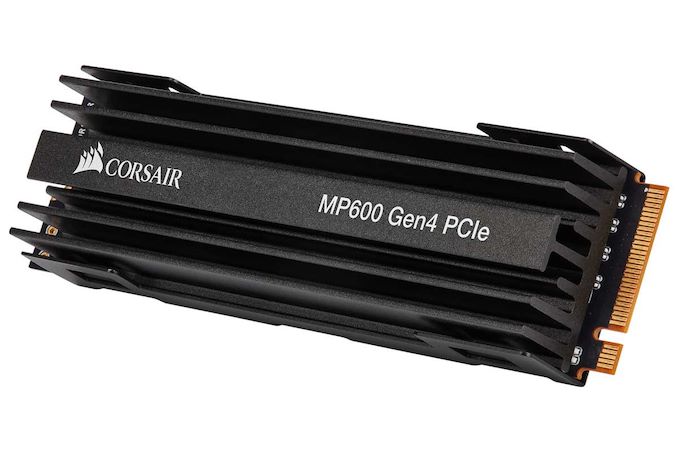Corsair Announces MP600 NVMe SSD With PCIe 4.0
by Billy Tallis on May 27, 2019 12:00 PM EST- Posted in
- SSDs
- Corsair
- Trade Shows
- Phison
- NVMe
- PCIe 4.0
- Computex 2019
- PS5016-E16

Now that AMD has kicked off the transition to PCI Express 4.0 in the consumer PC market, peripheral vendors are racing to follow suit. Phison is on track to deliver the first PCIe 4.0-capable NVMe controller for consumer SSDs, so many of their customers are announcing products based on the new PS5016-E16 controller. Corsair is one of the first in turn to announce their drive, with the new MP600 M.2 NVMe SSD.
The specifications disclosed so far for the MP600 are still incomplete, but the most important point is that the MP600 will be launching in July alongside AMD's new Ryzen 3000 series processors and their X570 chipset, both providing PCIe 4.0 lanes. Corsair hasn't specifically committed to launching on the same 7/7 date as AMD, but even shipping in the same month is a win for Phison and their partners. No other SSD controller vendor has announced a PCIe 4.0 capable client SSD controller, and even if that changes this week during Computex, Phison will almost certainly be first to market.
| Corsair Force Series NVMe SSD Comparison | |||||
| Model | MP600 | MP510 | MP500 | ||
| Form Factor | double-sided M.2 2280 (with heatsink) |
double-sided M.2 2280 |
double-sided M.2 2280 | ||
| Interface | NVMe, PCIe 4.0 x4 | NVMe, PCIe 3.0 x4 | NVMe, PCIe 3.0 x4 | ||
| Controller | Phison PS5016-E16 | Phison PS5012-E12 | Phison PS5007-E7 | ||
| NAND Flash | undisclosed 3D TLC | Toshiba 64-layer 3D TLC | Toshiba 15nm MLC | ||
| Capacities | ? | 240GB–1920GB | 120GB–960GB | ||
| Sequential Read | up to 4950 MB/s | up to 3480 MB/s | up to 3000 MB/s | ||
| Sequential Write | up to 4250 MB/s | up to 3000 MB/s | up to 2300 MB/s | ||
| Random Read | ? | up to 610k IOPS | up to 260k IOPS | ||
| Random Write | ? | up to 570k IOPS | up to 230k IOPS | ||
| Warranty | 5 years | 5 years | 3 years | ||
| Write Endurance | ? | 1.0 DWPD | 0.7 DWPD | ||
| Release Date | July 2019 | October 2018 | December 2016 | ||
The MP600 will be capable of up to 4950MB/s for sequential reads and 4250MB/s for sequential writes, both significant increases over any consumer SSD currently available, such as the MP510 it will be replacing. That performance likely only applies to the largest capacity MP600, but Corsair hasn't announced what specific capacities will be available; our guess is that the product line will go up to the same 1920GB as the MP510. The MP600 includes a simple black heatsink over the M.2 module, which may actually be necessary to hit the new higher speeds.
Pricing for the MP600 has not yet been announced. The warranty will be the usual 5 years, but write endurance has not been announced. And, of course, the drive will be backwards-compatible with existing PCIe 3.0 systems.
| Want to keep up to date with all of our Computex 2019 Coverage? | ||||||
 Laptops |
 Hardware |
 Chips |
||||
| Follow AnandTech's breaking news here! | ||||||










10 Comments
View All Comments
halcyon - Monday, May 27, 2019 - link
Did they even announce the storage size options?ballsystemlord - Monday, May 27, 2019 - link
I'm really looking forward to your review of this drive!5080 - Monday, May 27, 2019 - link
That headsink wouldn't work with M.2 slots at the underside.Irata - Monday, May 27, 2019 - link
Nothing from Samsung on the horizon ?haukionkannel - Monday, May 27, 2019 - link
All in good time! Most likely Samsung version before the end of summer!MDD1963 - Tuesday, May 28, 2019 - link
Can't imagine Samsung will let this go unanswered...! :) I'm sure there is a 980 Pro somewhere!Algernop - Monday, May 27, 2019 - link
Any idea what the low queue depth IOPS are going to be? That's what really matters on consumer level installations...It kind of bothers me to see companies shotgunning out hardware advertising the 'highest' numbers without showing what the real world numbers are. Not everyone uses these as database drives!
Tryad - Tuesday, May 28, 2019 - link
This is what I want to know. Is there any improvement in THIS area? Thats what matters the most.Skeptical123 - Monday, May 27, 2019 - link
It's nice to see m.2 NVMe drives getting proper heatsinks. I assume this drive needs such a large to keep the driver chip cool. Current high-end drives have been on the threshold of needing heatsinks for a while now. To the point I think Samsung market some of their M.2 drives with sticks that acted as small heatsinks. I assume the only reason heatsinks are not more common is they, because even if they are not needed you know manufactures will add them for looks, is took keep the size down so they can fit in all the right length M.2 slots. These new drives can't fit on the back of motherboards or more commonly under 2 slot GPUs. Though I assume the new AMD boards that support PCIe gen 4 will take this into account. I hope